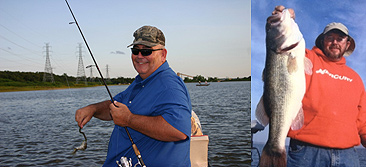Partnerships for Environmental Public Health (PEPH)
Academic Partners:
Harvard School of Public Health
Laurel A. Schaider, Ph.D.
University of Oklahoma Health Science Center
Community Partner:
Local Environmental Action Demanded, Inc.

Photo credits: Grand Lake Dam Authority, Martin Landing
Project Description
The Grand Lake watershed in northeastern Oklahoma is downwind and downstream from several major mercury pollution sources. Grand Lake is heavily fished by local recreational and subsistence anglers. Researchers from the Harvard School of Public Health and the University of Oklahoma Health Sciences Center collaborated with Local Environmental Action Demanded (LEAD) to quantify mercury contamination in this watershed and to address community concerns about the safety of the fish. This partnership sought to reduce exposure to mercury from contaminated fish while protecting the cultural practices of American Indian subsistence fishers.
Exposure to the neurotoxin methylmercury through consumption of fish is a major public health concern, especially among children and women of childbearing age. American Indians, who often rely on subsistence fishing practices, consume up to 20 times more fish than the general U.S. population. However, unique rates of fish consumption, species consumed, and food preparation techniques typical of American Indians and other ethnic populations are often not considered in risk assessment frameworks.
The partners involved in this project were interested in finding out whether people who regularly catch and consume fish from Grand Lake watershed (particularly members of the area's American Indian, Hispanic, and Micronesian populations) have higher body burdens of mercury compared to other residents of the same community who do not frequently consume local fish as well as the general U.S. population.
The project partners:
- Found that, in contrast to the general U.S. population, freshwater species contributed the majority of fish consumption (69 percent) and dietary mercury exposure (60 percent) among study participants, despite relatively low mercury concentrations in local fish.
- Observed that hair mercury levels increased with fish consumption, age, and education, and were higher among male participants and the lowest in winter.
- Saw significant variations in fish mercury levels among locations in Grand Lake and Lake Hudson, although overall mercury levels were relatively low compared to other reservoirs in Oklahoma.
- Found that fish in local farm ponds — commonly used in the agricultural regions for raising game fish — had 2 to 17 times higher mercury levels than fish of similar length in nearby reservoirs.
- Observed that pH, water color, rainfall, and nutrients were the best predictors of fish mercury levels across systems, which partially explains the relatively low mercury levels in fish in Grand Lake and Lake Hudson.
The researchers’ findings suggest that future studies involving anglers should consider seasonality in fish consumption and mercury exposure and include household members who share their catch, particularly women and children. Efforts to evaluate benefits of reducing mercury emissions should consider dietary patterns among consumers of fish from local freshwater bodies, and keep in mind that small water bodies such as farm ponds may be especially enriched in mercury.
This partnership promoted safe subsistence fishing practices in a contaminated watershed by educating community members on ways to reduce the amount of mercury ingested. The partnership also empowered community members with information to work with state and regional agencies to develop consumption advisories and promote reduction of mercury emissions.
Selected Publications:
- Dong Z, Lynch RA, Schaider LA. 2016. Key contributors to variations in fish mercury within and among freshwater reservoirs in Oklahoma, USA. Environ Sci Process Impacts 18(2):222-236. [Abstract Dong Z, Lynch RA, Schaider LA. 2016. Key contributors to variations in fish mercury within and among freshwater reservoirs in Oklahoma, USA. Environ Sci Process Impacts 18(2):222-236.]
- Dong Z, Jim RC, Hatley EL, Backus AS, Shine JP, Spengler JD, Schaider LA. 2015. A longitudinal study of mercury exposure associated with consumption of freshwater fish from a reservoir in rural south central USA. Environ Res 136:155-162. [Abstract Dong Z, Jim RC, Hatley EL, Backus AS, Shine JP, Spengler JD, Schaider LA. 2015. A longitudinal study of mercury exposure associated with consumption of freshwater fish from a reservoir in rural south central USA. Environ Res 136:155-162.]


